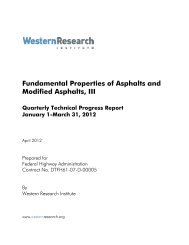Fundamental Properties of Asphalts and Modified Asphalts, III
Fundamental Properties of Asphalts and Modified Asphalts, III
Fundamental Properties of Asphalts and Modified Asphalts, III
You also want an ePaper? Increase the reach of your titles
YUMPU automatically turns print PDFs into web optimized ePapers that Google loves.
SUBTASK 2-6: VALIDATION SITE MONITORING<br />
Statement <strong>of</strong> Problem<br />
Laboratory tests <strong>and</strong>/or models to predict the performance <strong>of</strong> asphalt pavement materials have<br />
always needed a connection between the original materials <strong>and</strong> actual performance in the field,<br />
especially comparative performance, in order to calibrate or validate the test or model results.<br />
Approach<br />
The approach being used is to construct field sections where different asphalt sources <strong>of</strong> the<br />
same Performance Grade are used at the same location so that comparative pavement<br />
performance can be directly evaluated <strong>and</strong> core samples can be obtained as the comparative<br />
pavements age in service. Original materials were collected at the time <strong>of</strong> construction <strong>and</strong> are<br />
available for testing. The sites being monitored, using LTPP monitoring protocols, were<br />
constructed during the previous FHWA contract, “<strong>Fundamental</strong> <strong>Properties</strong> <strong>of</strong> <strong>Asphalts</strong> <strong>and</strong><br />
<strong>Modified</strong> <strong>Asphalts</strong> II”.<br />
Goal<br />
The goal <strong>of</strong> this subtask is to provide accurate <strong>and</strong> documented performance <strong>of</strong> different asphalt<br />
sources that also includes asphalt-aggregate interactions, to be used to determine the chemical<br />
<strong>and</strong> physical property differences that are important to pavement performance.<br />
Support <strong>of</strong> FHWA Strategic Goals<br />
This subtask supports the FHWA Strategic Goal <strong>of</strong> Optimizing Pavement Performance.<br />
Work Conducted this Quarter<br />
The annual monitoring <strong>of</strong> the Kansas comparative pavement validation site was conducted in<br />
May 2008. The site is still performing rather well after six years in service; however, there is<br />
some distress being noted. There is a small amount <strong>of</strong> fatigue cracking <strong>and</strong> longitudinal cracking<br />
(both non-wheelpath <strong>and</strong> in the wheelpath) that is occurring in two <strong>of</strong> the sections. Two core<br />
samples were obtained by KDOT personnel to investigate one <strong>of</strong> the fatigue cracks. The core<br />
samples revealed that the cracking is top-down cracking <strong>and</strong> only goes through the 40 mm top<br />
lift. The four comparative asphalt sources are located in the bottom 60 mm <strong>of</strong> the pavement with<br />
a 60 mm binder course <strong>and</strong> a 40 mm surface course placed above. There were no apparent<br />
indications in the two core samples that there was any problem with the bottom lift.<br />
Work to be Conducted Next Quarter<br />
It is planned to perform the annual monitoring <strong>of</strong> the Wyoming Highway 216 sections <strong>and</strong> the<br />
Nevada I-15 sections in August <strong>and</strong> September 2008, respectively.<br />
71





